PSG often appear like a team poised to contend for the UEFA Champions League, yet they consistently fall short.
Whether it’s Karim Benzema scoring a hat-trick to knock them out, losing to Borussia Dortmund despite being favourites after beating them in the group stage, missing key opportunities in the UCL final against Bayern, failing to score a single goal against Bayern in the Round of 16, or the infamous 6-1 collapse against Barcelona, the club frequently looks like a leading contender for the trophy yet somehow always crumbles.
Over the years, PSG have signed several big-name players but have struggled to earn the same respect as other major clubs in the UCL.
The start of Luis Enrique’s tenure at PSG marks a fresh start: Kylian Mbappé is gone, Neymar is gone, and Lionel Messi left earlier as well.
Now is the time for players to blend together better and focus on chemistry rather than relying on a star player to carry them through.
This recruitment analysis will examine the players PSG has brought in, some key stats about them, and how they are being utilised at PSG.
With an average squad age of 24, they are one of the most promising young and talented squads that could finally bring the UCL trophy to Paris.
PSG Areas Of Improvement
PSG have faced numerous struggles, from attack to defence, and in 2023/24, they brought in several quality players to address these gaps.
While Marquinhos has been a solid centre-back, he never found an exceptional partnership with another defender.
Their full-backs, though promising young talents, are still developing into world-class players.
PSG needed a new centre-back to complement Marquinhos, and that’s where Lucas Beraldo comes in.
The club had a busy transfer window, strengthening their squad across all areas.
In defence, they added Lucas Hernández from Bayern Munich for €45m, bringing valuable experience to their backline.
They also signed young Brazilian talent Lucas Beraldo from São Paulo for €20m and signed experienced defender Milan Skriniar on a free transfer from Inter Milan.
PSG made significant upgrades in midfield.
Kang-in Lee, a creative South Korean playmaker, joined from RCD Mallorca for €22m.
18-year-old defensive midfielder Gabriel Moscardo was signed from Corinthians for €20m.
João Neves came from Benfica for €60m, a player many clubs monitored.
The attack also underwent a major change.
Randal Kolo Muani was a massive signing, arriving from Eintracht Frankfurt for €95m, and Gonçalo Ramos joined from Benfica.
Those were the two key strikers they brought in.
Ousmane Dembélé arrived from FC Barcelona for €50m, and Bradley Barcola, another promising winger, came from Olympique Lyon for €45m
Marco Asensio joined on a free transfer from Real Madrid to complete the attacking rebuild.
The Idea Behind The Transfers
PSG’s approach shifted toward bringing in young, talented players with potential rather than relying on senior players with established experience, a strategy they had in the past with stars like Gianluigi Buffon, Edinson Cavani, Zlatan Ibrahimović, Lionel Messi, Sergio Ramos, and Georginio Wijnaldum.
The plan now was different: assemble a youthful squad that could grow together, build chemistry, and develop a style of play to excel to the next level.
And that’s exactly what they did.
The club prioritised players with versatility, moving away from one-dimensional signings.
They looked for players who could adapt to multiple roles and positions.
For example, Marco Asensio can play on either wing, as a false 9, or in the number 10 role.
Ousmane Dembélé can operate on either flank, and Kang-in Lee can function as a winger or a midfielder.
Manuel Ugarte is flexible enough to fill any midfield role.
Lucas Hernández can play as a fullback, a centreback in a two-defender system, or as part of a back three.
Their newest signing, João Neves, can slot into both the 6 and 8 roles, while his Portuguese teammate Vitinha, one of the world’s top midfielders, excelled in multiple roles in last season’s Champions League.
PSG abandoned the idea of signing ageing stars with hefty price tags and high wages.
It was now time for youth to take over the club, which was exactly their direction.
For now, we will only look at the transfers since Luis Enrique.
PSG Defensive Players
Their defence, which had often lacked the calmness and composure needed to secure crucial victories, was the number one issue PSG needed to address.
They brought in key reinforcements to tackle this: Beraldo, Lucas Hernández, and Milan Skriniar.
Beraldo is the youngster they want to develop into a star, and the other two were brought in for immediate results.
We won’t focus on him here, with Skriniar on his way out.
Lucas Hernández Radar Chart Analysis
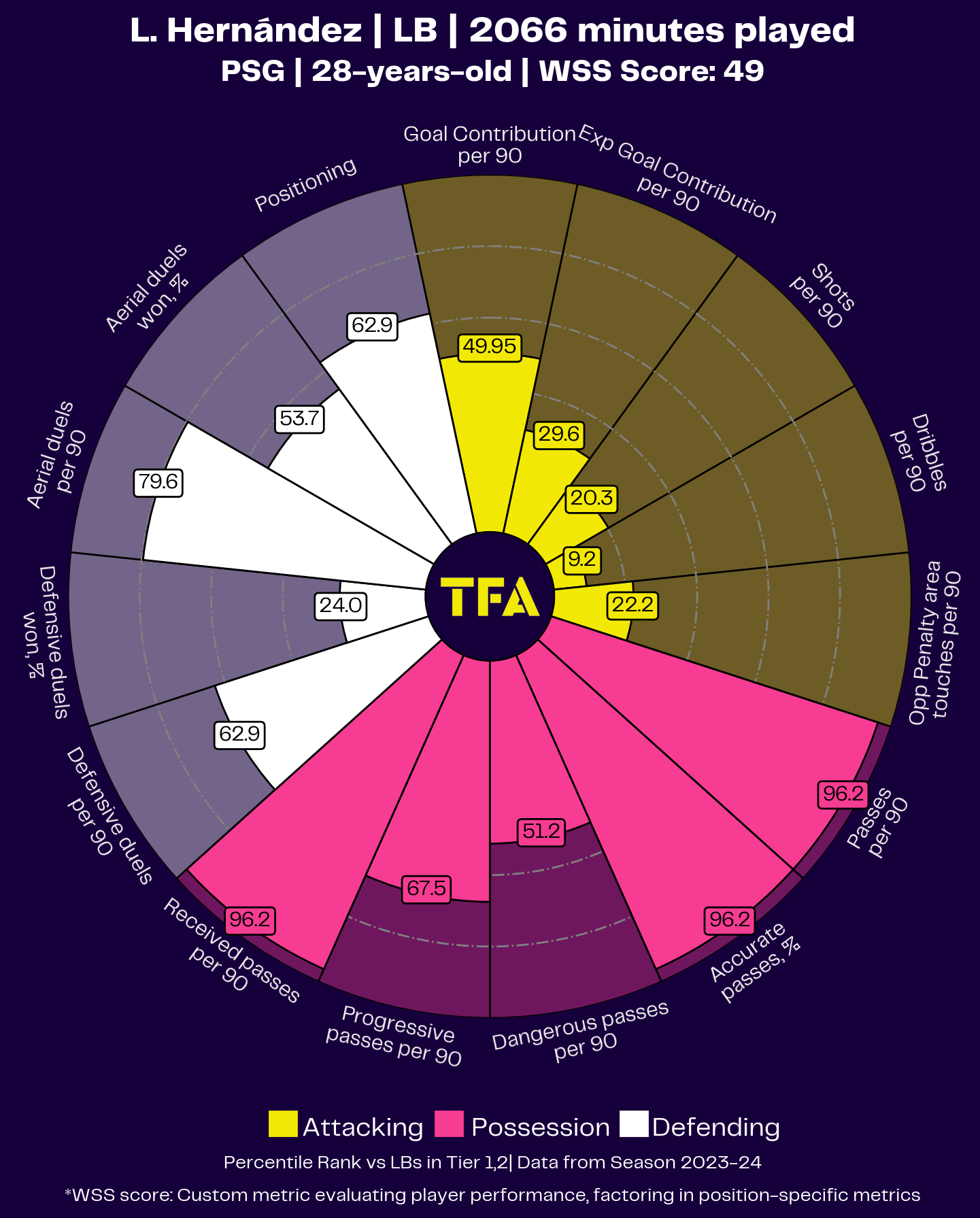
Based on his radar chart, Lucas Hernández stands out as a highly capable defender.
His win percentage in aerial duels is solid at 79.6%, showcasing his ability to dominate aerial battles.
Additionally, his defensive duels won percentage is decent at 62.9%.
When it comes to his passing statistics, Hernández ranks highly, with 96.2% accuracy in passes per 90 minutes and a 96.2 percentile rank in received passes.
He is a perfect partner for a three-back.
He has great ability as a passer and the required defensive aggressiveness.
His versatility in defensive and possession metrics highlights his value to PSG’s backline.
Lucas Beraldo Radar Chart Analysis
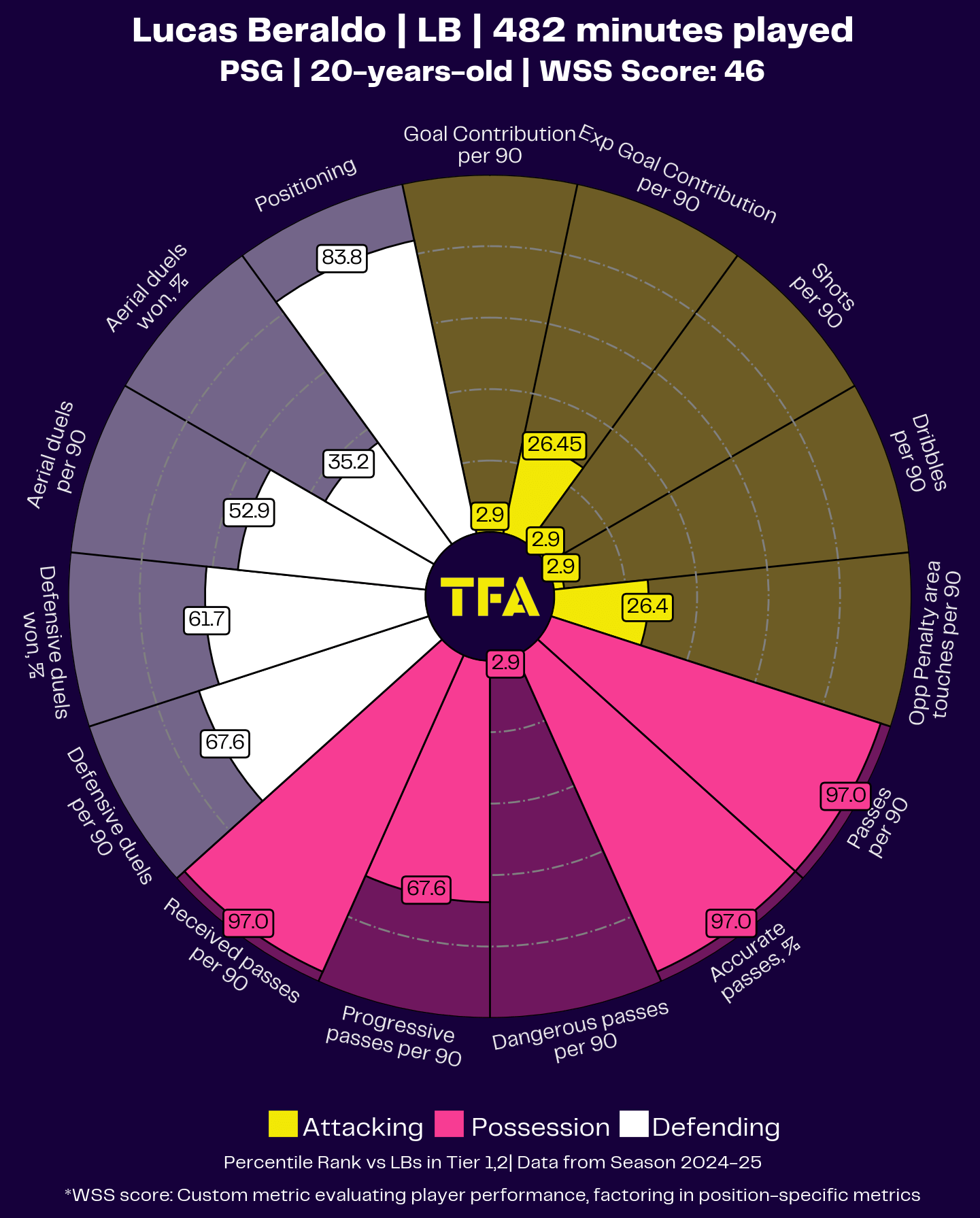
Despite his younger age, Lucas Beraldo shows great potential as a defender.
His aerial duels won percentage is impressive at 83.8%, and his defensive duels won percentage is 61.7%.
On the ball, Beraldo excels in possession, with 97.0% accuracy in passes per 90 minutes and in the 97.0 percentile rank in received passes, which shows his composure and accuracy on the ball to help the team during build-up play.
PSG Midfield Players
PSG’s midfield has always been a point of concern.
In the past, their over-reliance on Verratti made it seem like a lost cause when he wasn’t at his best.
However, under Luis Enrique, the club has brought in two key players to strengthen this area, and we will now take a closer look at their radar charts.
Lee Kang-In Radar Chart Analysis
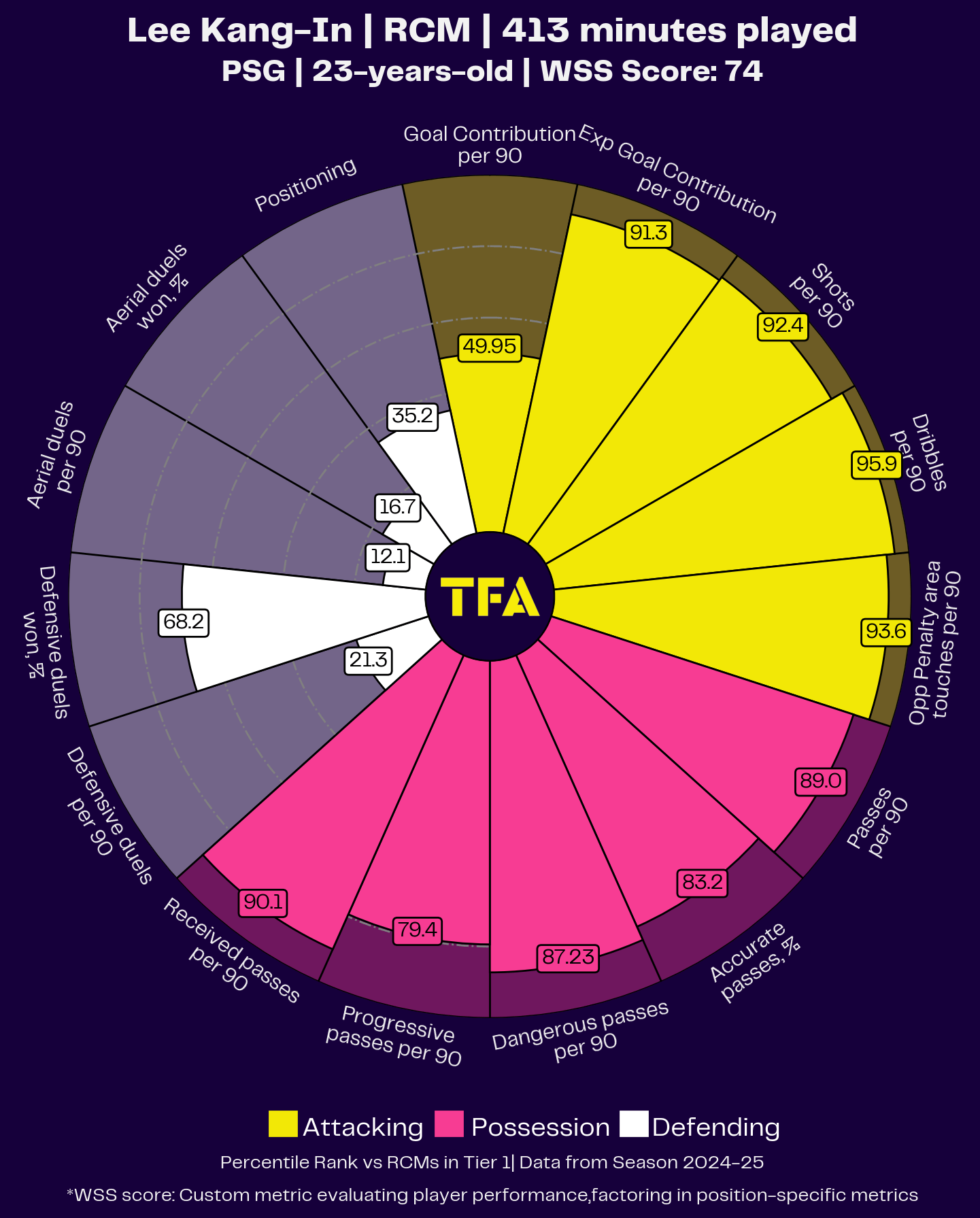
Lee Kang-In is very versatile and reliable.
He has good passing metrics, with an 89.0% pass accuracy and a high ranking in dangerous passes per 90 in the 87.23 percentile, making him a reliable playmaker in possession.
He also ranks highly in progressive passes per 90 in the 79.4 percentile, which shows his ability to advance the ball and create dangerous passes forward as both a winger and midfielder.
Defensively, Kang-In has a 68.2% win rate in defensive duels.
Although he is not a 6, this shows how he can contribute in defence.
João Neves Radar Chart Analysis
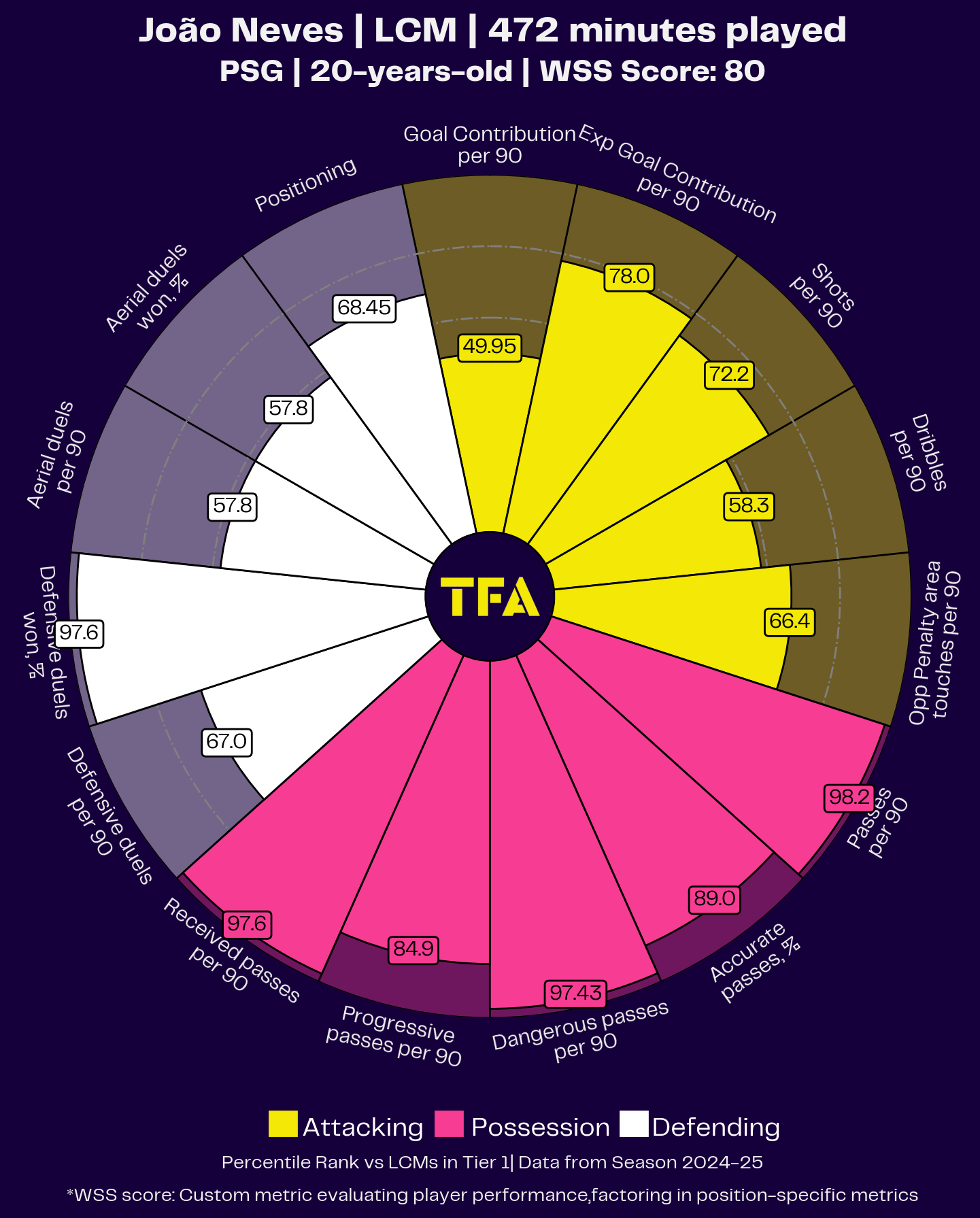
João Neves is the club’s star midfield player.
His 97.43 percentile in dangerous passes per 90 and 84.9 percentile in progressive passes per 90 make him a key player in playing passes into the final third.
His 97.6 percentile in received passes per 90 highlights his pivotal role in linking up with teammates and controlling the midfield during all phases of the pitch.
Defensively, Neves is not a typical 6.
He roams in that area as a deep-lying playmaker but has a 67.0% success rate in defensive duels and a solid 68.45% winning percentage in aerial duels.
PSG Attacking Players
Their attack is the most fascinating part of PSG’s project.
Since Neymar, Messi, and Mbappé’s departures, the club has brought in several players to fill the void left by their world-class attacking talent.
In their rebuilding phase, PSG has recruited standout players from the French league and abroad to diversify their attacking options.
This new approach emphasises creating a dynamic, versatile front line that adapts to different styles and challenges.
Bradley Barcola Radar Chart Analysis
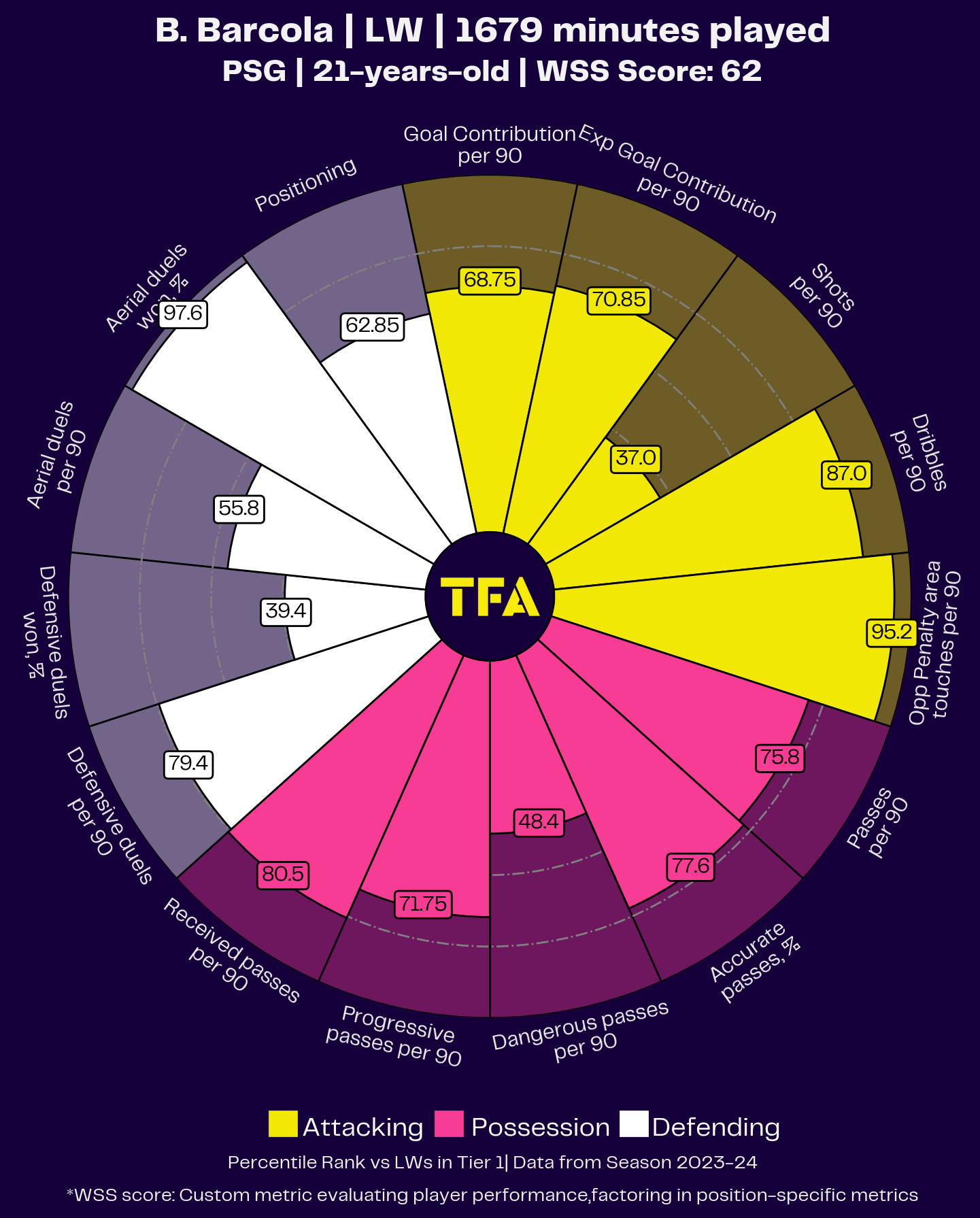
Bradley Barcola is their new star boy in attack. His goal contribution per 90 minutes puts him in the 68.75 percentile, and his expected goal contribution is in the 70.85 percentile.
His ability to push his team forward in attacking phases is evident in his 95.2 percentile in passes into the penalty area per 90 and his strong dribbling stats that put him in the 87.0 percentile.
This is his breakout season at the top flight, and he looks like the Kylian Mbappé replacement.
Ousmane Dembélé Radar Chart Analysis
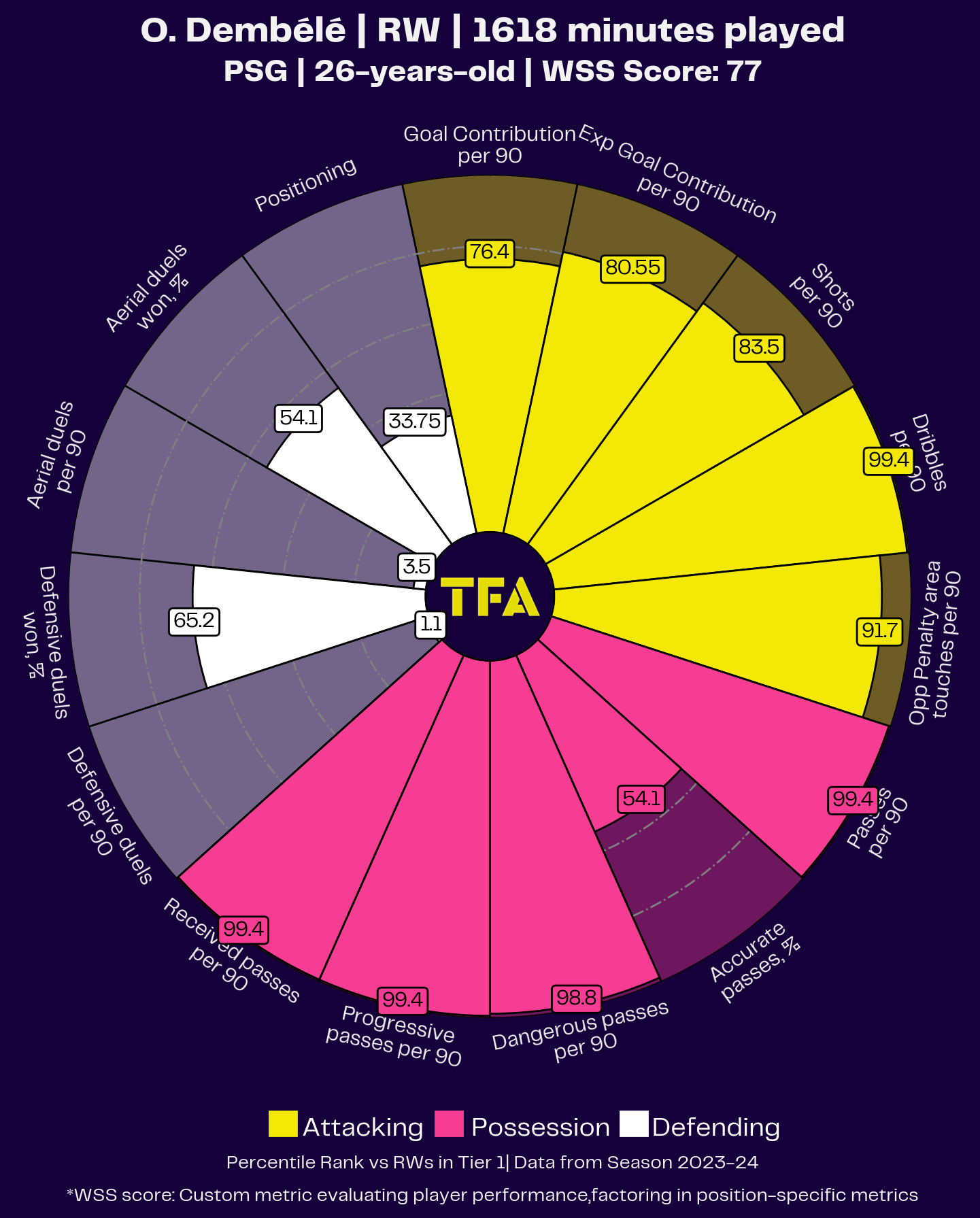
Ousmane Dembélé ranks in the 76.4 percentile for goal contribution per 90 minutes and in the 80.55 percentile for expected goal contribution.
He is one of the best dribblers in the world, with stats that put him in the 99.4 percentile.
His 91.7 percentile in passes into the penalty area per 90 makes him a crucial link in PSG’s attacking setup.
Dembélé has always been an exceptional winger; the question is whether he can stay healthy.
As the saying goes, “availability is the best ability,” and he has been a key player on the opposite wing to Barcola in PSG’s attacks.
Gonçalo Ramos Radar Chart Analysis
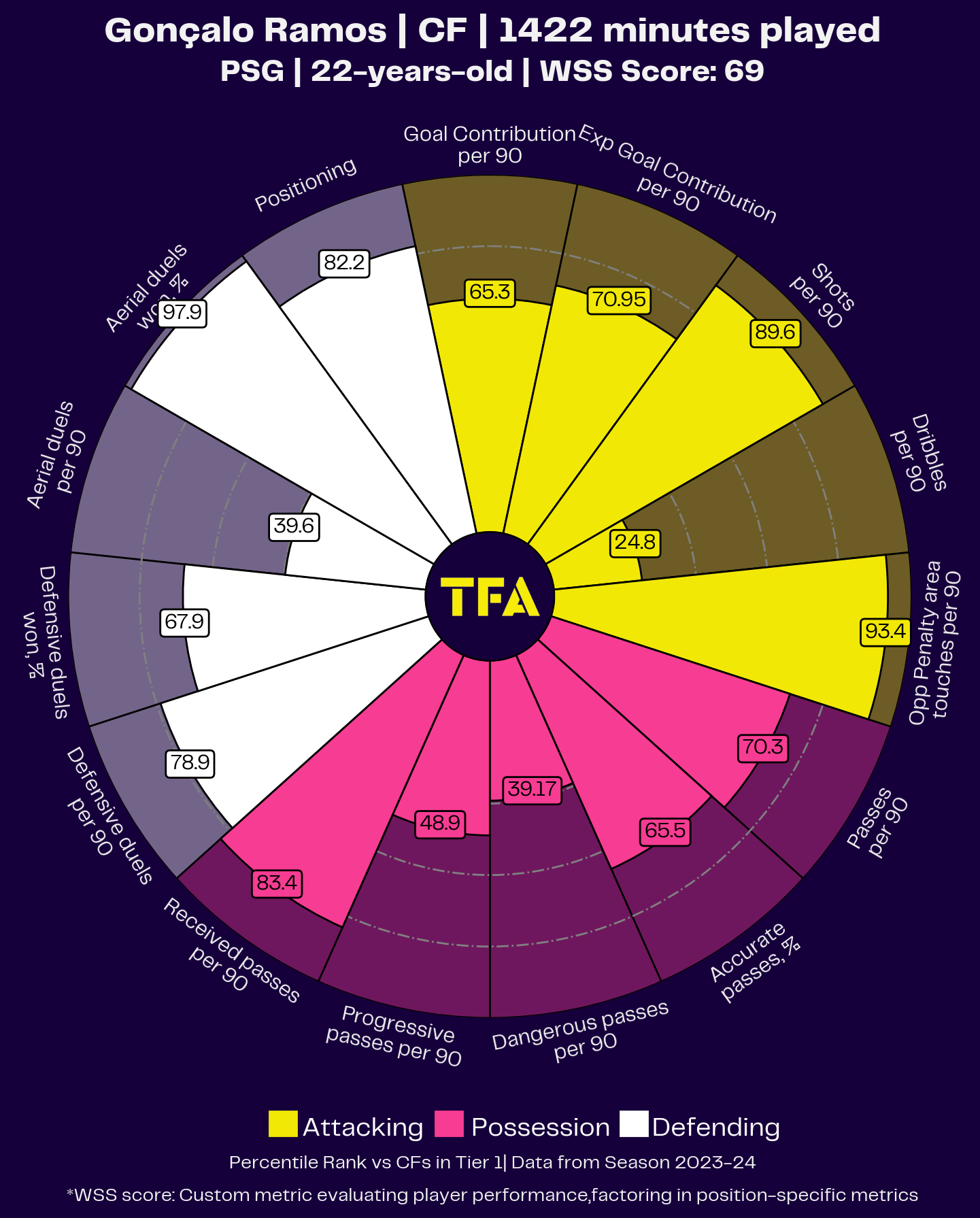
Gonçalo Ramos is a consistent threat in attack, as shown by his 65.3 percentile in goal contributions per 90 minutes and 70.95 percentile in expected goal contribution.
He ranks in the 93.4 percentile for penalty area touches per 90 and in the 89.6 percentile in shots per 90.
Ramos is one of the best young strikers in the world.
He competes with Randal Kolo Muani for the position, which affects his consistency, but nonetheless, he delivers great performances for both club and country.
Randal Kolo Muani Radar Chart Analysis
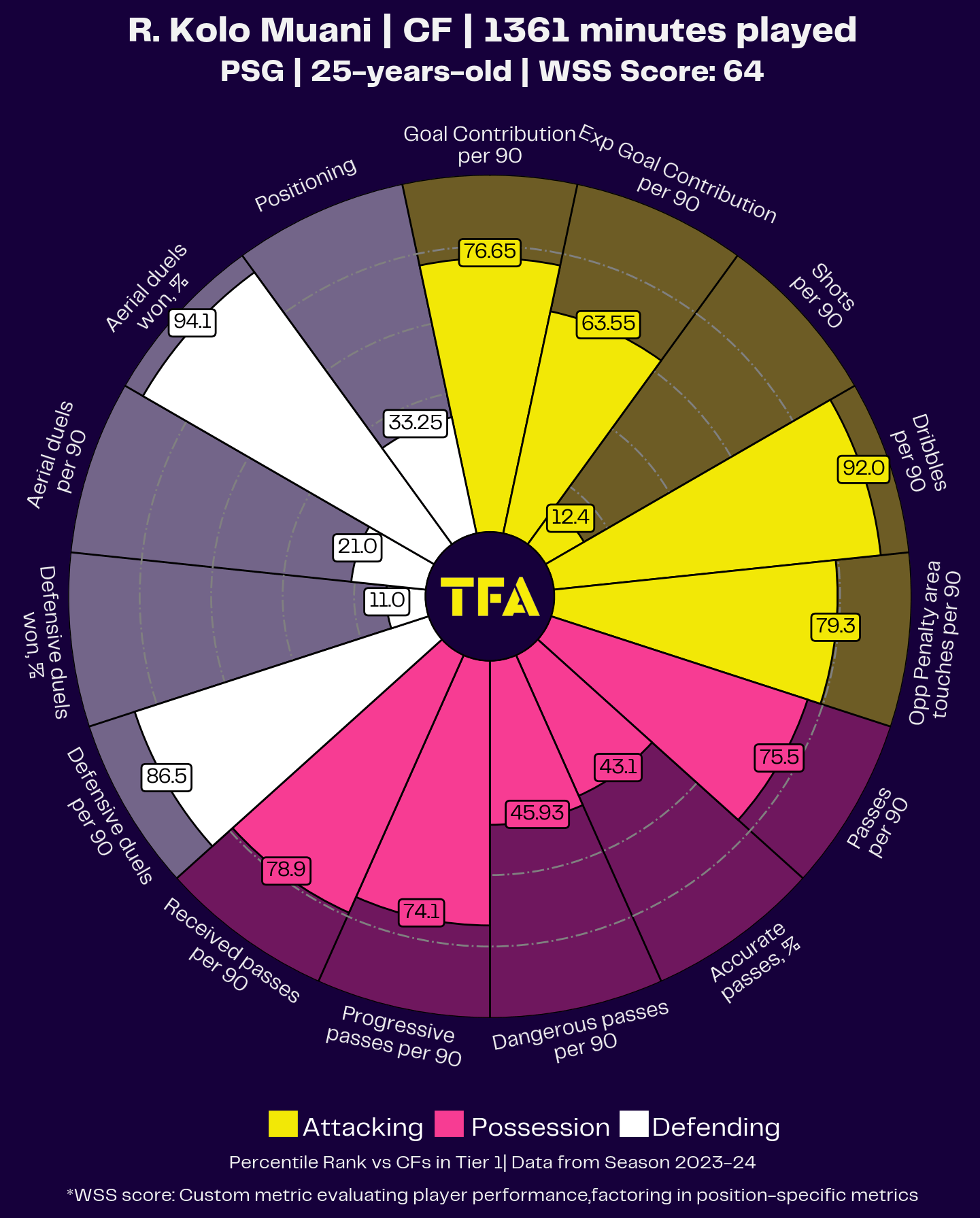
Randal Kolo Muani competes with Ramos for the club’s main striker position and is also one of the best strikers for the French national team.
He ranks in the 76.65 percentile for goal contributions per 90 minutes and the 63.55 percentile for expected goal contributions.
His 92.0 percentile for shots per 90 demonstrates how frequently he serves as a shooting outlet and looks toward goal.
Additionally, his 79.3 percentile for penalty area touches per 90 highlights his movement and ability to position himself effectively in dangerous attacking zones.
What Is Their Potential?
This squad’s potential has a very high ceiling.
In the 2021/22 and 2022/23 seasons, PSG exited the Champions League in the Round of 16.
However, during the 2023/2024 season, they reached the semi-finals—a significant improvement under a new coach and with a revamped squad.
Although they fell short in the semi-finals, the progress was evident.
If PSG can maintain this momentum, they could soon contend for a spot in the UCL final.
Domestically, Ligue 1 titles remain relatively straightforward for the club, given their superior financial resources and squad depth.
The ultimate goal, however, is to finally bring the Champions League trophy to Paris.
With their current squad, PSG are well-positioned to consistently compete for Europe’s top honour over the next five to six years.

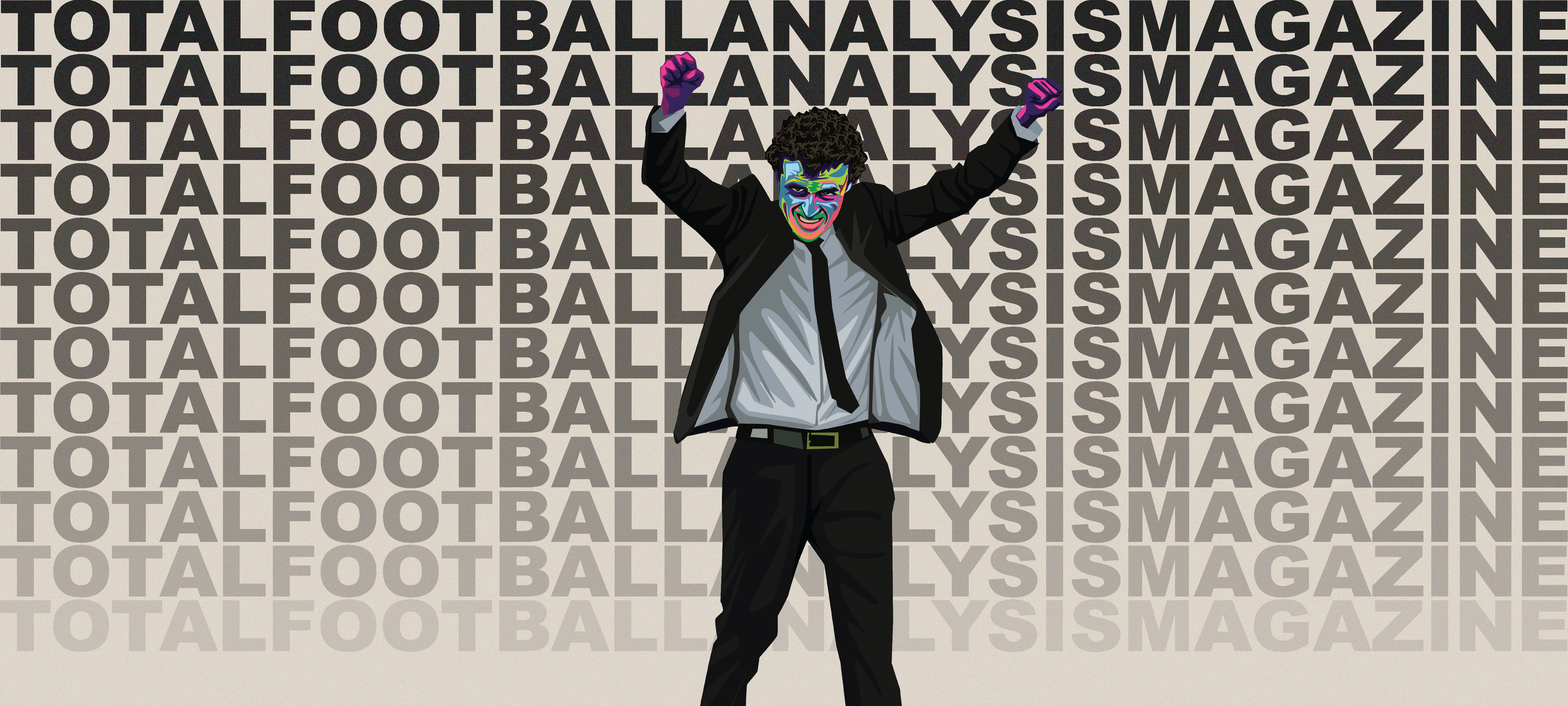



Comments